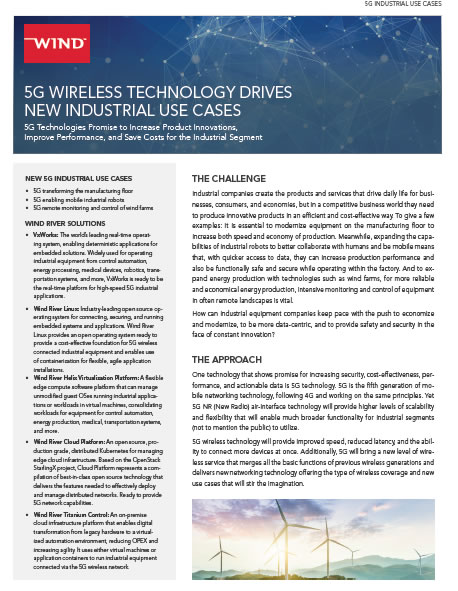How can industrial equipment companies keep pace with the push to economize and modernize, to be more data-centric, and to provide safety and security in the face of constant innovation?
Case Study from | Wind River
THE CHALLENGE
 Industrial companies create the products and services that drive daily life for businesses, consumers, and economies, but in a competitive business world they need to produce innovative products in an efficient and cost-effective way. To give a few examples: It is essential to modernize equipment on the manufacturing floor to increase both speed and economy of production. Meanwhile, expanding the capabilities of industrial robots to better collaborate with humans and be mobile means that, with quicker access to data, they can increase production performance and also be functionally safe and secure while operating within the factory. And to expand energy production with technologies such as wind farms, for more reliable and economical energy production, intensive monitoring and control of equipment in often remote landscapes is vital.
Industrial companies create the products and services that drive daily life for businesses, consumers, and economies, but in a competitive business world they need to produce innovative products in an efficient and cost-effective way. To give a few examples: It is essential to modernize equipment on the manufacturing floor to increase both speed and economy of production. Meanwhile, expanding the capabilities of industrial robots to better collaborate with humans and be mobile means that, with quicker access to data, they can increase production performance and also be functionally safe and secure while operating within the factory. And to expand energy production with technologies such as wind farms, for more reliable and economical energy production, intensive monitoring and control of equipment in often remote landscapes is vital.
How can industrial equipment companies keep pace with the push to economize and modernize, to be more data-centric, and to provide safety and security in the face of constant innovation?
To learn how industrial equipment companies keep pace with the push to economize and modernize, to be more data-centric, and to provide safety and security in the face of constant innovation, read this Wind River use case, “5G Industrial Use Cases”.
The content & opinions in this article are the author’s and do not necessarily represent the views of RoboticsTomorrow
Comments (0)
This post does not have any comments. Be the first to leave a comment below.
Featured Product


